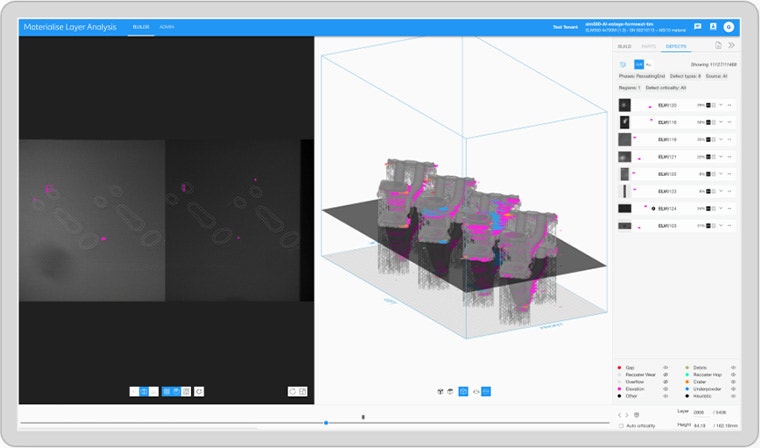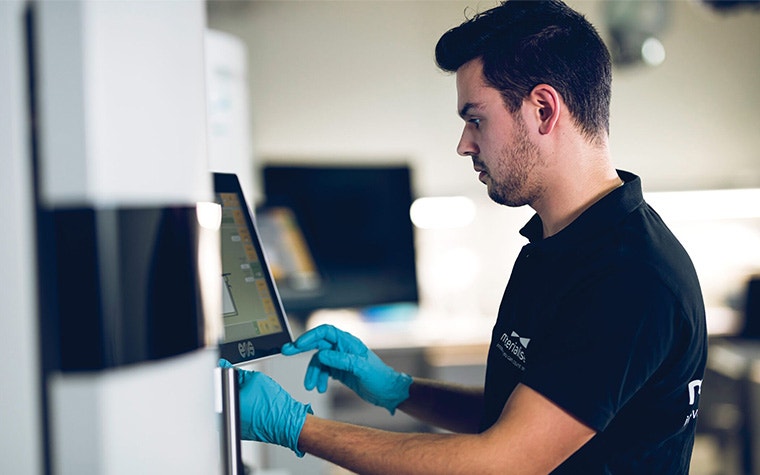EXPERT INSIGHT
5 Ways Layer Analysis Software Can Enable Metal 3D Printing Quality Control in the Most Demanding Industries

Metal additive manufacturing (AM) is ideal for creating end-use parts that are difficult to produce using conventional methods. This unique technology is gaining popularity due to its design flexibility and mechanical properties, especially in industries with strict requirements, like aerospace and medtech. However, it’s also a challenging technology to master, and build failures don't only impact your company's carbon footprint, they can also be costly — up to 70% of part costs come from time-intensive post-processing and quality inspection processes. So, the key to maximizing your metal AM ROI and meeting your industry’s demands is to get to the root cause by detecting anomalies and defects earlier in the production cycle with solutions such as the Quality & Process Control (QPC) Layer Analysis software.
Laser powder bed fusion (LPBF), a type of metal 3D printing, is the leading segment for AM, accounting for over 52% of the global revenue in 2022.1 It’s also one of the most complex technologies to use, with many potential challenges. In fact, one stumbling block — the lack of effective and economical quality control — is slowing down the adoption of AM. This stems from some pain points described to us by companies in our recent survey, such as a lack of knowledge, prohibitive costs, and perceived complexity.
But what if you could use AI-based software to fail fast, automating the analysis so that you could scrap defective parts earlier in your production cycle for continuous improvement during your root cause analysis (RCA) investigation? Now you can with the help of Materialise Layer Analysis, a module in our QPC System.
Here are five ways this layer analysis tool enables quality assurance and quality control for your metal 3D printing (3DP) production, saving you time and resources.
1 — See anomalies and use defect auto-detection
Quickly visualize anomalies mapped to the 3D model and layer images
QPC Layer Analysis provides a 360° overview of the quality of your build in seconds, helping you accelerate your decision-making to determine whether a build should enter the post-processing, finishing, and quality control workflow.
You can avoid expensive unnecessary manufacturing steps — such as post-processing, quality inspections, and non-destructive testing (NDT) — thanks to the early scrap detection based on QPC Layer Analysis.


As the tool makes it easy to locate AI-identified anomalies and defects in a 3D-modeled build, you’re able to optimize your RCA and parameter development. Plus, the module not only detects anomalies and defects earlier in the process but also fuels continuous improvement programs, helping teams optimize yield loss.
During the RCA process, Quality and R&D Engineers can collaborate to identify whether non-conformance stems from the 3D printer, the part’s design, the support structures, or the material’s characteristics by leveraging Layer Analysis’ data with other modules found in the QPC software, which monitors machine sensor data. By leveraging 1D, 2D, and 3D data sources, organizations can connect the dots to accelerate their parameter development or conduct preventive maintenance measures on their equipment to ensure everything meets the required specifications.
2 — Automate manual workflows and easily collaborate with colleagues
Simplify online collaboration by flagging observations and leaving comments
Layer imaging technology provides a lot of insight into build quality; however, without the right tools, AM operators must manually process more than 10,000-layer images per build. This results in non-standardized outputs due to the reviewer-dependent nature of the procedure. Not to mention, the process is often labor-intensive and time-consuming. That's where QPC Layer Analysis makes a difference, providing the data you need in seconds.
You can even create personalized filters based on defect size, volume, and probability to guarantee quality and consistency for your chosen application and production standards. In addition, you’re able to quickly flag and discuss issues from the RCA with your team members and other departments using the flagging function — enhancing communication and speeding up collaboration to increase productivity. It’s the ideal collaborative tool to analyze AM build quality.
3 — Create configurable reports
Configure quality reports that are standardized across machines


Analyzing layer images manually is usually only part of the issue: creating reports can be just as time-consuming and prone to human error. These factors can be mitigated with QPC Layer Analysis software. The tool instantly creates a report of the most critical defects flagged by the system that are relevant to your application, enabling consistency when creating quality reports across different 3D printer OEM brands while standardizing your quality reporting processes.
For example, the module allows you to filter based on the number of anomalies that cover a range of three or more layers. Then, you can automatically generate an analysis report with all the defects with screenshots showing their characteristics based on each layer.
Normally, conducting a manual review with defects (including writing a report) for a medium-sized machine takes approximately 45 to 60 minutes per build, not to mention the risk of human error. And for larger machines, this can increase up to 2 hours per build. However, with QPC Layer Analysis, creating a fully automated report can be done in a matter of seconds.
4 — Accelerate collaboration and decision-making between teams
Enhance communication between different team members quickly and effectively
With QPC Layer Analysis, team members from different departments, from the Production Manager and Quality Engineer to the R&D Engineer can work together and stay engaged. Combined with the tool’s use of AI, team members are able to collaborate at speed, boosting the group’s decision-making capabilities and the project’s quality results. This is one of the significant advantages of visual imaging software; it facilitates quicker problem-solving and, ultimately, increases your AM time-to-market.
5 — Boost cost-saving by confidently scrapping parts earlier
Enable first time right (FTR) initiatives with a hardware- and software-agnostic solution
Many AM facilities use a variety of hardware and software from different vendors to identify if a part is within a customer’s specifications or out-of-spec. Although this offers companies more flexibility and customization, it also can cause compatibility issues with equipment, which could decrease efficiency and disrupt production cycles, ultimately affecting lead times.
These issues are compounded when scrap is identified too late in the production chain, leading to increased production costs and workloads. Plus, demanding industries, such as aerospace and medical end-use parts, require certified production, which usually follows new product introduction (NPI) processes. Speeding up the NPI process is challenging because of the many design-to-print cycles and parameters involved to create a final recipe for production. As data comes from different sources and machines, with many steps in the process, conducting an accurate RCA is even more difficult than usual, especially if data is siloed across multiple manual, software, and hardware systems.


Using an agnostic AM software solution reduces metal 3DP analysis and production complexity. QPC Layer Analysis works with existing or newly installed cameras connected to your LPBF printer to analyze each layer; it's even possible to run side-by-side comparisons with other layer data.
Correlating in-situ sensor data and post-build data across different machines (regardless of the brand) and using software that offers completely automated analysis increases the FTR rate of 3D-printed parts, potentially cutting the total manufacturing costs by up to 70%. The result is a solution that offers faster root cause analyses, more detailed inspection (of high-risk areas), and identification of scrap even earlier in the production chain.
An added advantage of FTR with Layer Analysis is meeting your sustainability goals. Companies everywhere are trying to cut back on waste, and failed builds are one of the largest streams of waste in AM.2 With long-term improvements enabled by AI-identified defects and parameter optimization plus build simulation before you start printing, you'll introduce lasting impact into your operations that only gets better over time. Fewer rebuilds equal less material usage, lower CO2 emissions, and more eco-conscious production.
Move fast, stay aligned, and build better
Use AM solutions on the bleeding edge to meet your industry’s demands
AM has been recognized as an Industry 4.0 technology with the potential to increase supply chain agility by enabling on-demand distributed manufacturing to meet consumer and industrial demand. Companies can use layer analysis software to meet those demands. It’s well-suited for industries that require certified components, patient-specific parts, or mass customization, and many sectors are already leveraging digital supply chain programs.
Quality control within your metal AM process doesn't stop here. Combining Layer Analysis with Simulation adds a quality check earlier in your design workflow — visualizing potential problem areas before 3D printing. And it’s an essential part of a wider range of AM agnostic software — QPC and the CO-AM Software Platform — that enables companies to plan, control, and optimize every step of their AM operations.
Share on:
You might also like
Never miss a story like this. Get curated content delivered straight to your inbox.
